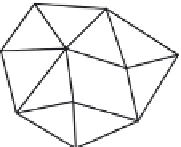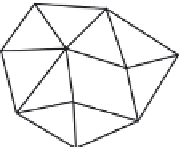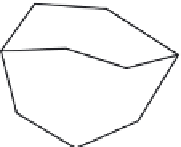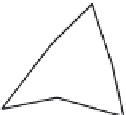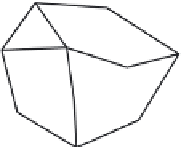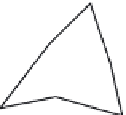Graphics Reference
In-Depth Information
Λ
ν
1
Λ
ν
2
Λ
ν
3
ν
1
ν
1
ν
1
ν
2
ν
2
ν
2
Δ
t
Δ
t
Δ
t
ν
3
ν
3
ν
3
Λ
ν
1
Δ
t
Λ
ν
3
Δ
t
Λ
Δ
t
ν
1
ν
2
Λ
ν
+
+
Λ
Λ
3
ν
1
ν
2
Δ
t
ν
3
ν
1
Δ
t
ν
2
Δ
t
ν
3
Δ
t
Λ+
Λ +
Λ=1
Figure 5.19
Basis (weighting) functions for spreading a vertex light field across adjacent triangles. Top
row: there is one basis function Λ
v
j
for each vertex. The value of a basis function, which
is shown in gray (darkest gray is 1, white is 0), has a value of 1 at the vertex and ramps
down to zero at the far edge of each adjacent triangle in the ring. Bottom: the weighting
functions for the three vertices of triangle
t
sum to 1 across the triangle. (From [Chen
et al. 02]
c
2002 ACM, Inc. Included here by permission.)
of position and direction. This kind of variable separation is a standard technique
and had already been applied to surface reflectance functions [Fournier 95, Kautz
and McCool 99]. The primary contribution of the paper came in the method the
authors proposed for the approximations.
The authors actually propose two approximation methods, both of which use
matrix factorization applied to a collection of samples of each vertex light field
function. One method employs
principal component analysis
(PCA) to find, in
a manner of speaking, the best basis for the matrix. The result is a sequence of
samples that approximate the function in the sense that the contributions decrease,
so a limited number of terms provides a useful approximation. However, the re-
sulting sample values can be negative. The authors point out that this complicates
a hardware implementation. In contrast,
nonnegative matrix factorization
(NMF)
requires all the terms to be used, but the sample values are all nonnegative. In ei-
ther case, the light field function
f
t
over triangle
t
is a discrete approximation
of the form
3
j
=
1
g
v
j
f
t
h
v
j
[
r
p
,
s
p
,
θ
q
,
φ
q
]=
t
[
r
p
,
s
p
]
[
θ
q
,
φ
q
]
.
The “functions”
g
and
h
are actually 2D arrays of values, i.e., textures, that the
authors describe as a
surface map
and a
view map
, respectively.
















